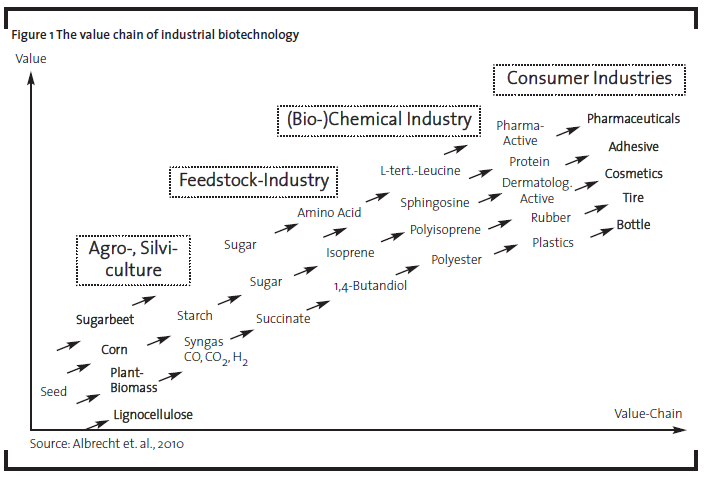Industrial biotechnology becomes a key competitive factor
Industrial biotechnology is established since decades in producing diverse products such as enzymes, amino acids, enantiomerically pure pharma-actives and more (Haas et al., 2010). However, in spite of these successful examples biotechnology still plays a minor role in the chemical industry, accounting for only 3-6% of the global sales volume. It is more or less only successful in those niches where petro-chemistry does not work: enzymes and enantiomerically pure products are simply not available by chemical synthesis. This limitation is going to be cleared away through modern biotechnology. Beside the products already mentioned before, non-natural chemicals will be also available. They will be the future precursors in procedures combining biotechnology and chemical synthesis.
Bio-/chemical processes will be the crucial building block of the future production system sweeping the entire industry. It is the vision of an industry predominantly based on raw materials, which recycles auxiliary and end products. A core element of this vision, as unanimously supported by the European Union as Knowledge-Based Bio-Economy (KBBE) and by the German government as BioÖkonomie, is industrial biotechnology (Research DG, 2005; King & Hagan, 2010). Accelerating this development needs more joint and strong efforts of industry and academia in pushing the recently emerging synthetic biotechnology, improving continuous processes, reducing downstream processing costs and integrating biotechnological and synthetic process steps. While reaching commercial success through early R&D is not guaranteed, public support is necessary and already given. However, public funding should take even more consideration of industrial relevance, including projects that are close to the commercialization stage, such as pilot plants.
At this point the future feedstock market needs to be discussed. When the chemical industry enters the agricultural market it will compete with producers of food, feed, fibers, rubber, and increasingly bio-energy. Therefore the chemical industry is eager to explore alternatives to agricultural feedstock like lignocellulosic agricultural waste and wood. Providing commercial solutions in this field is another common and urgent challenge to academic and industrial process development.
Incorporating the perspective of the European chemical industry regarding the competitive availability of renewable feedstock is of particular relevance. With Europe’s limited agricultural area its industry will largely depend on imports from countries and regions, such as the US, Brazil, South-East Asia and Russia (King & Hagan, 2010). When the future trend of producing bulk precursors from renewable carbon sources for chemical applications is gaining momentum, such production units may be most competitive in those regions. Therefore, European chemical sites, with no renewable carbon resources nearby, are forced to focus continuously on the competitiveness of their processes and a sustained pipeline of value-adding products. In some way industrial biotechnology is an innovation driver itself: the more successfully it achieves industrial transformation of renewable feedstock, the more it becomes a critical competitive factor.
Establishing industrial biotechnology is an extremely complex issue. Numerous hurdles need to be overcome. Questions of science (synthetic biology), technology (integration of biotech- and synthetic process steps), feedstock availability (infrastructure), politics (legislative framework), training (academic and technical staff) and public acceptance need to be answered. However, the biggest challenge may arise from the development of a new, agricultural and silvicultural value chain reaching from feedstock- and biochemical transformation to consumer industries (Figure 1, Kircher, 2006).
It is obvious that walking this way alone is too challenging even for big companies. To be successful, industries need access to scientific, technical and business competencies in all steps of the value chain. Therefore, in Germany the cluster CLIB2021, (Cluster industrielle Biotechnologie 2021 e.V.), supported by the German Federal Ministry of Education and Research (BMBF) and the Ministry of Innovation, Science and Research of the German state of NRW (MIWF), has been founded.
Today this type of cluster-forming is widely perceived to be most promising in paving the way to the KBBE. Recently, the European Commission acknowledged 3 European clusters as role models: the Bio-Hub in France, the BE-Basic in the Netherlands and the CLIB2021 in Germany (Research DG, 2005). Through partnering along the biotechnological value chain, such organized clusters are crucial in winning the global competition in industrial biotechnology. All academic, industrial and financing stakeholders should join. The time is right now!
References
Albrecht J., Carrez D., Cunningham P., Daroda L.,Mancia R.,Máthé L., Raschka A., CarusM., Pietrowski St. (2010): The Knowledge Based Bio-Economy in Europe (KBBE): Achievements and Challenges, European Commission, p. 37-42.
BMBF (2010): National Research Strategy BioEconomy 2030.
Haas Th., Kircher M., Köhler T., Wich G., Schörken U., Hagen R., (2010): White Biotechnology, R. Höfer (ed.) Sustainable Solutions for Modern Economics. RSC Green Chemistry Series, 12, p.436-474.
King D., Hagan A., (2010): The Future of Industrial Biorefineries, World Economic Forum, 21.
Kircher, M. (2006): Biotechnology: Ready to Partner and Invest, Biotechnol. J., 1, p.787-784 (modified).
Research DG (2005): New Perspectives on the Knowledge-Based Bio-Economy, EU Commission, p. 1-19.
